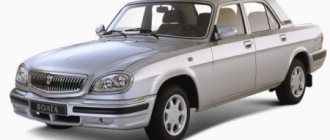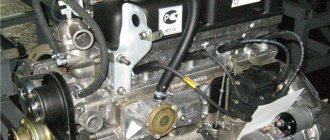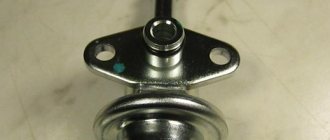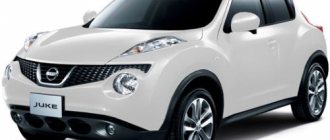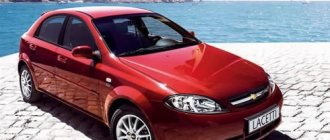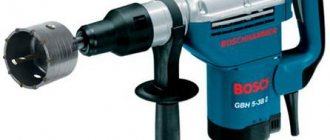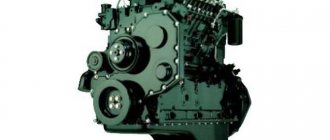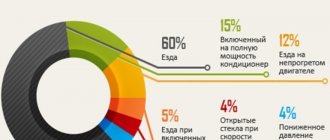The ZMZ 406 engine was being developed to replace the 402 engine simultaneously with the design of the GAZ-3105 car for the government. However, these new Volgas were equipped with them only for the last batch, which had to be urgently sold due to the removal of the cars from production.
ICE ZMZ 406
The basis was taken from the ZMZ 402 (equipment) and the H series engine from the manufacturer SAAB (design solutions). As a result, with the same volume of 2.3 liters, the power drive provided 177 Nm of torque instead of the prototype’s 210 Nm and 100 hp. With. power instead of the expected 150 hp, like the Swedish internal combustion engine. The injection system, which later replaced the carburetor, was able to improve the situation slightly - 201 Nm and 145 hp. s., respectively.
Carburetor version ZMZ 4061.10
For the first time, several advanced technical solutions for that time were used in the engine of the manufacturer ZMZ:
- two intake and two exhaust valves per cylinder;
- electronic ignition and injection systems;
- diagram of the DOCH gas distribution mechanism with two overhead camshafts;
- hydraulic pushers instead of adjusting the thermal clearance of valves with gaskets.
Valve tappets
After the changes made, the technical characteristics of ZMZ 406 correspond to the values given in the table:
| Manufacturer | ZMZ |
| Engine brand | 406 |
| Years of production | 1997 – 2008 |
| Volume | 2286 cm3 (2.3 l) |
| Power | 73.55 kW (100 hp) |
| Torque moment | 177/201 Nm (at 4200 rpm) |
| Weight | 192 kg |
| Compression ratio | 9,3 |
| Nutrition | injector/carburetor |
| Motor type | in-line petrol |
| Ignition | switchboard |
| Number of cylinders | 4 |
| Location of the first cylinder | TVE |
| Number of valves on each cylinder | 4 |
| Cylinder head material | aluminum alloy |
| Intake manifold | duralumin |
| An exhaust manifold | cast iron |
| Camshaft | 2 pcs. DOCH scheme |
| Cylinder block material | cast iron |
| Cylinder diameter | 92 mm |
| Pistons | original |
| Crankshaft | lightweight |
| Piston stroke | 86 mm |
| Fuel | AI-92/A-76 |
| Environmental standards | Euro-3/Euro-0 |
| Fuel consumption | highway – 8.3 l/100 km combined cycle 11.5 l/100 km city – 13.5 l/100 km |
| Oil consumption | maximum 0.3 l/1000 km |
| What kind of oil to pour into the engine by viscosity | 5W30, 5W40, 10W30, 10W40 |
| Which engine oil is best by manufacturer | Liqui Moly, LukOil, Rosneft |
| Oil for ZMZ 406 by composition | synthetic in winter, semi-synthetic in summer |
| Engine oil volume | 6.1 l |
| Operating temperature | 90° |
| ICE resource | declared 150,000 km actual 200,000 km |
| Adjustment of valves | hydraulic pushers |
| Cooling system | forced, antifreeze |
| Coolant volume | 10 l |
| water pump | with plastic impeller |
| Spark plugs for ZMZ 406 | domestic A14DVRM or A14DVR |
| Spark plug gap | 1.1 mm |
| Valve train chain | 70/90 with shoe or 72/92 with sprockets |
| Cylinder operating order | 1-3-4-2 |
| Air filter | Nitto, Knecht, Fram, WIX, Hengst |
| Oil filter | with check valve |
| Flywheel | 7 offset holes, 40mm inner diameter |
| Flywheel mounting bolts | M12x1.25 mm, length 26 mm |
| Valve stem seals | Goetze, light intake, dark exhaust |
| Compression | from 13 bar, difference in adjacent cylinders maximum 1 bar |
| XX speed | 750 – 800 min-1 |
| Tightening force of threaded connections | spark plug – 31 – 38 Nm flywheel – 72 – 80 Nm clutch bolt – 19 – 30 Nm bearing cap – 98 – 108 Nm (main) and 67 – 74 (rod) cylinder head – three stages 40 Nm, 127 – 142 Nm + 90° |
The factory manual contains a more precise description of the parameters:
- ZMZ 4063.10 – carburetor, compression ratio 8 for operation on A-76 fuel, power 110 hp. s., torque 186 Nm, weight 185 kg;
- ZMZ 4061.10 – carburetor, compression ratio 8 for A-76 gasoline, power 100 hp. s., torque 177 Nm, weight 185 kg;
- ZMZ 4062.10 – injector, compression ratio 9.3 for AI-92 fuel, power 145 hp. s., torque 201 Nm, weight 187 kg.
ZMZ 4063.10
ZMZ 4062.10 injector
Gazelle 406 (injector) - fuel consumption per 100 km
- City cycle: 13.0 l
- Extra-urban cycle: 12.0 l
- Mixed cycle: 11.0 l
A huge number of freight transports are carried out using Gazelles, which are manufactured at the Gorky Automobile Plant. The 406 engine is presented in three modifications - two carburetor and injection, including. It should be noted that the latest engine can be installed not only on minibuses, but even on passenger cars.
As for the advantages of this engine, its amazing efficiency comes to the fore, given its fairly high power. If handled correctly, the engine will be reliable and last a long time. The only thing is that it is harmful in terms of the quality of oil and spark plugs. Frequent overheating of the engine is also possible because the cooling system does not work correctly, and the fan may fail altogether.
Well, you can never do without disadvantages and this engine is no exception. In general, this unit is quite reliable among its competitors and is in demand and respect among car enthusiasts. You don’t have to worry about spare parts either, since stores have a wide range of parts for this engine. Considering the exorbitant prices for repairing engines from foreign manufacturers, the 406 model is quite inexpensive to maintain, which is very good.
The volume of both carburetor and injection engines is about 2.5 liters. But, what is very important, the first carburetor engine should be filled with 76 gasoline, the injection engine with 92 gasoline, and the second carburetor also with 92 gasoline. Power varies from 100 to 145 horsepower, depending on the modification.
If you look at the model range of domestic automobile companies, you can come to the conclusion that minivans are not a priority direction for the development of mechanical engineering. There has always been a buyer for this category of cars, but in most cases they preferred to acquire an imported minibus. In 1998, the Gorky Automobile Plant decided to enter the post-Soviet market with its offer in the form of a van.
It was then that the first copy of the Russian minivan, the GAZ 2217, rolled off the assembly line. The model is better known among the people as the “Sable Barguzin”; the design of the engineers of the Gorky Automobile Plant received this name in honor of the powerful winds of Lake Baikal. We will tell you in detail about the characteristics of the car and what the fuel consumption of the GAZ 2217 per 100 km is in this article.
Advantages and disadvantages
A negative feature of the ZMZ 406 power drive is the low quality of casting and poor technical solutions:
- high oil consumption due to unfinished ring design;
- low timing life of the drive due to the tensioner, collapsible block star and bulky design as a whole.
Fuel consumption is high, but this is typical for most truck engines.
But vibrations are reduced, the cylinder head does not unscrew during operation, the gasket does not need to be constantly changed, and the nuts do not need to be tightened. The maintainability of all components is high, the design itself is reliable and simple. The user is spared the need to adjust valve clearances every 20,000 miles.
Intake manifold injector
Line of power units
During its existence, Sobol Barguzin has undergone many cosmetic and technological changes. Initially, the car was equipped with a ZMZ-402 carburetor engine with a displacement of 2.5 liters. Later, 16-valve engines appeared: also with a ZMZ-406.3 carburetor power system and an injection 406 engine. Both engines were characterized by a power of more than 100 horsepower; there were modifications with varying degrees of boost up to 110 horsepower. The same power units were installed on the Gazelle.
In 2003, the company carried out a planned restyling, during which Barguzin was not only transformed externally, but also received technologically advanced power plants. For some time, the injection 405 version, which complies with Euro-3 standards, became the main engine. Since 2010, the minivan has been equipped with a UMZ-4216 engine, and a few months later the manufacturer announced the start of production of the Cummins ISF 2.8 turbodiesel with a capacity of 130 horses. The line of power units has received a wide variety, but not all developments have found appropriate application and praise from drivers.
Fuel consumption rate for GAZ 2217, certified by the manufacturer
Unlike the GAZ 3302, the Sobol Barguzin has a shorter wheelbase, an independent front suspension, a ceiling lowered by 10 cm, a lifting rear door and the ability to transport up to 900 kg of cargo. The car began to be actively used for commercial purposes, for travel and family use. The Gorky Automobile Plant has established the following fuel consumption standards in the city/highway cycle for various engine modifications:
- ZMZ 405 – 13/11 l;
- UMZ 4216 – 13/10 l;
- Cummins ISF 2.8 – 10/7 l;
- Chrysler 2.4 – 11/9 l.
As a transmission, all varieties of Sobol Barguzin 4x4 are equipped with a 5-speed manual gearbox, coupled to the power unit via a single-plate dry clutch. In the 4x4 modification, a single-lever transfer case has found its application. The first generation of minibuses came with independent front wishbone suspension and rear leaf spring suspension.
Gasoline consumption of Sobol Barguzin 4x4 according to owner reviews
Engine displacement and the degree of boost are not all the parameters that you should pay attention to when searching for a suitable GAZ 2217 4x4 configuration. It is important to choose a minivan modification that can satisfy the owner’s needs without significant costs for refueling. There are different opinions on the network regarding the level of Sobol Barguzin fuel consumption per 100 km of travel. The following feature must be taken into account: the fuel consumption rate specified by the manufacturer was established during testing of the vehicle under ideal conditions. Obviously, the actual figures will be somewhat different.
Gasoline units: ZMZ 405, UMZ 4216, Chrysler 2.4
- Alexey, Moscow. In 2007, I purchased a 7-seater Barguzin with a 405 engine from scratch. Before that, I drove a Volkswagen Transporter, but due to objective reasons I had to change my workhorse. At the time of running-in, the “appetite” of my minivan was simply crazy, it reached 18 liters per 100 km. After passing the first 5 thousand km, the figure began to return to normal - 13 liters in the city and 11 liters on the highway.
- Ivan, Rostov. Since 2008 I have owned a light-duty truck GAZ 2217, during which time I have developed quite warm impressions of the Sobol. Of course, interior comfort suffers somewhat, but for me this is not the main thing. You should drive this car carefully, and when transporting cargo, do not overload it, then fuel costs will be minimal. I have a modification ZMZ-405 - it consumes 10-11 liters in winter and summer, on the highway 9 liters on average.
- Evgeniy, Tyumen. “Sobol Barguzin” is an excellent car, suitable for use in various fields. Torque, assertive and reliable, but it’s better not to get carried away with off-road trips - you can get bogged down. You can reduce fuel consumption on the GAZ 2217 by adjusting your driving style, since you need to know how to drive this car! I drive a 2010 modification with a Chrysler 2.4 engine - I can’t say anything bad. At first I was tearing up at a traffic light, because there are 140 horsepower under the hood - I want to try it. But it’s not worth the money that you had to leave at the gas station, because the figure increased to 15 liters! The norm is 10-11 liters in the city.
- Stanislav, Yekaterinburg. I have a Sobol Barguzin from 1999 with a carburetor 409 engine. I note that the fuel consumption indicator is too dependent on the carburetor settings. The quality of gasoline also affects the level. The average figures are as follows: 12.5 liters city in summer and 13 liters in winter, on the highway 10 liters per 100 km at a cruising speed of 120 km/h
Engine ZMZ 402
The most common engine that GAZ engines could boast of was the ZMZ 402. It was produced from the beginning of 1980 until 2006. Now you can find it exclusively in a maintained form.
This GAZ engine is the most common, as it has been produced for more than 20 years, which makes it easy to find the necessary spare parts and carry out repairs.
In terms of technical characteristics, it is not particularly different from its predecessors:
- The engine cylinder is made of aluminum, the power supply system is carburetor.
- Maximum engine capacity – 2115 cm3.
- This engine has quite high fuel consumption - up to 14 liters per 100 km in the city.
- One of the main advantages of this engine is its versatility, thanks to which it can be used on almost all GAZ cars.
Breakdowns and repairs of the ZMZ 402 engine
Despite the high quality and mass production of the Gazelle ICE engine, breakdowns still occur. These include the following malfunctions:
One of the most fragile parts in the ZMZ 402 engine is the crankshaft oil seal. It is made from ordinary rope, pre-impregnated in graphite lubricant. The strength limit of such a part is up to 2500 rpm. If you exceed this figure, the crankshaft oil seal will simply begin to leak oil out. In order to avoid such unpleasant situations with ZMZ 402, the stuffing box should be replaced with a better one made of durable material; Abnormal vibration, unnatural sounds, and jerking may occur when the engine is idling. Such signs of malfunction may appear due to wear of the carburetor, since its design is initially crooked and is not the best solution implemented in Gazelle engines. Due to this feature, fuel is supplied to the engine cylinders in uneven parts, which leads to the malfunction described above; The occurrence of unhealthy sounds in the engine during its operation. Basically, the owner of a car with a GAZ engine is faced with knocking in the engine, which indicates a faulty fuel supply through the valve. In order to avoid such troubles, valve clearances should be adjusted in a timely manner. Basically, this car needs engine maintenance after every 15,000 km.
If the knocking does not occur due to a crooked valve, then you should turn your attention to the connecting rod bearings or the camshaft.
Due to its wide distribution, almost any breakdown of the ZMZ 402 can be corrected; it is enough to find out the cause of the malfunction and carry out high-quality repairs or replacement of the damaged part. This is why gazelle engines are not often completely replaced due to breakdown.
Modifications of ZMZ
There are also a large number of modified versions of ZMZ 402 engines, which were mass-produced and produced for cars of the same name.
The most common modifications include the following:
It is this modification that can most often be found among motorists in our country. It is installed on the Volga and works with 92 gasoline;
Not the best engineering solution for low-cost cars, as it contains a number of complex engineering solutions, such as a modified carburetor and an improved crankshaft.
Such innovations were supposed to increase the performance, efficiency, and reduce the toxicity of the GAZ engine. But in reality, not everything turned out so well, there was no expected efficiency, and the entire design required significant modifications;
It has no special differences from the 402 model, but was developed and used for cars of the Gazelle family.

